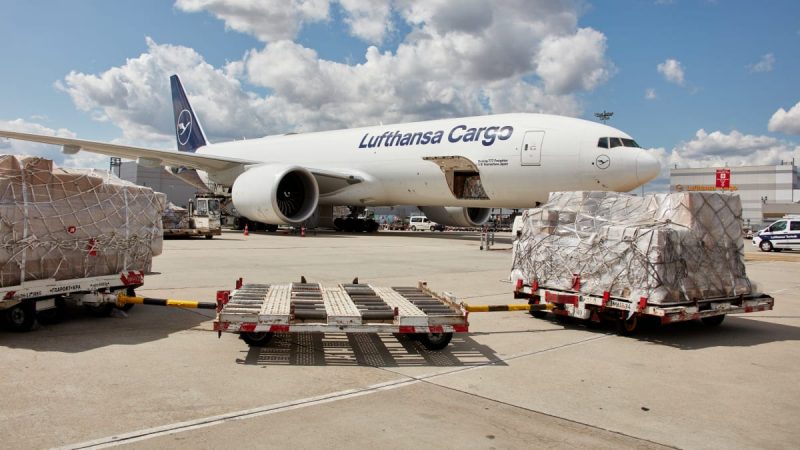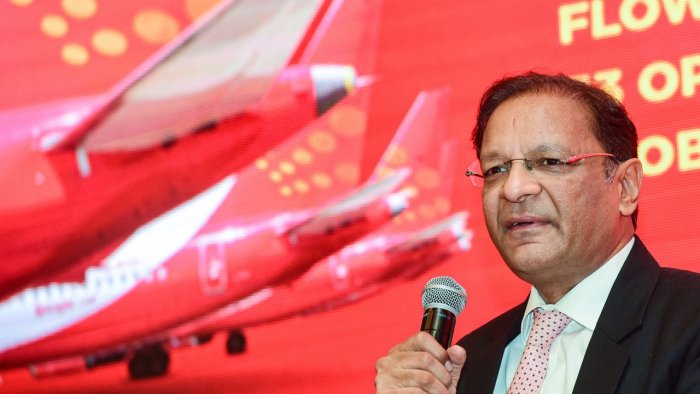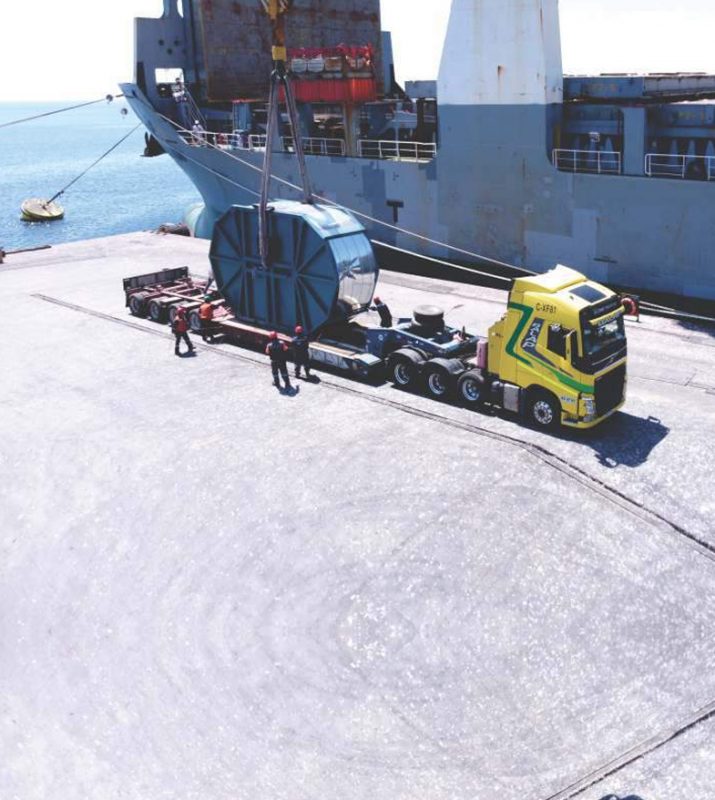Lufthansa Cargo ended 2021 with another record revenues totaling EUR 3.80 billion, the highest so far in its history, with cargo volumes handled for the period increasing to 7.2 billion freight ton kilometers (FTKs) from 6.5 billion the previous year.
That improved its average load factor by 1.7 percentage points year-on-year to 71.0 percent, while the supply of capacity increased by 8.7 percent to 10.1 billion freight ton kilometers offered.
 “We owe this result in particular to our employees, customers and partners. Together, we have managed to effectively maintain global supply chains even in times of pandemic. In addition to good revenues, the successful completion of our cost reduction program was a key factor in the good result. In 2022, we will continue to invest in customer focus, airfreight innovation and sustainability,” Dorothea von Boxberg, Chairman of the Executive Board and CEO of Lufthansa Cargo, said during the company’s annual press briefing held virtually for the third year in a row.
“We owe this result in particular to our employees, customers and partners. Together, we have managed to effectively maintain global supply chains even in times of pandemic. In addition to good revenues, the successful completion of our cost reduction program was a key factor in the good result. In 2022, we will continue to invest in customer focus, airfreight innovation and sustainability,” Dorothea von Boxberg, Chairman of the Executive Board and CEO of Lufthansa Cargo, said during the company’s annual press briefing held virtually for the third year in a row.
“In 2022, Lufthansa Cargo will focus on sustainability and the ongoing decarbonization of airfreight logistics. We are pleased to welcome numerous interested parties to our sustainable aviation fuel offerings and aim to expand the use of sustainable aviation fuels with various customers. In 2022, we will also begin to equip our freighters with Sharkskin technology, which will help us save fuel. In the area of digitalization, we are working at full speed to convert to fully electronic air waybills, among other things.”
 However, von Boxberg also puts customers in the mood for continuing challenges in logistics for the time being: “The issue of scarce capacity will continue to occupy us and our customers this year. With the marketing of the capacities of our first A321 freighter, which has just started, we want to offer customers new options for the ever-growing e-commerce sector, especially in the medium-haul segment. In addition, belly capacities on Lufthansa Group airlines will again increase significantly this year. We are currently examining further options to increase our capacity offering. At present, however, we also see that the situation in airfreight remains dynamic and that we have to react to developments on the world market at short notice and remain flexible.”
However, von Boxberg also puts customers in the mood for continuing challenges in logistics for the time being: “The issue of scarce capacity will continue to occupy us and our customers this year. With the marketing of the capacities of our first A321 freighter, which has just started, we want to offer customers new options for the ever-growing e-commerce sector, especially in the medium-haul segment. In addition, belly capacities on Lufthansa Group airlines will again increase significantly this year. We are currently examining further options to increase our capacity offering. At present, however, we also see that the situation in airfreight remains dynamic and that we have to react to developments on the world market at short notice and remain flexible.”
Last year, Lufthansa Cargo successfully implemented important projects of its corporate strategy. For example, the fleet modernization to a pure, highly efficient B777F freighter fleet was completed.
This currently comprises 15 aircraft, two of which were newly flown last year. The twin-engine Boeing 777F is considered the most efficient, modern freighter in its class. In addition, Lufthansa Cargo distributes the additional load capacities of Lufthansa, Austrian Airlines, Brussels Airlines, Eurowings Discover and SunExpress.
Sustainable aviation fuels were also a focus at Lufthansa Cargo in 2021: In addition to weekly CO2-neutral freight rotations between Europe and Asia, customers have been able to use the “Sustainable Choice” add-on service since last summer and thus have their freight transported in a CO2-neutral manner. Lufthansa Cargo also became a pilot customer for the first industrial power-to-liquid (PtL) plant to promote the development and research of synthetic PtL aviation fuel.
Lufthansa Cargo started the past financial year with positive expectations. Due to the continuing effects of the pandemic, freight capacities remained scarce worldwide despite increased demand. Marked by a noticeable cooling of the airfreight market prior to the Corona pandemic, the cargo airline had already launched a structural cost-cutting program in 2019, which is also contributing to the current result.
First A321 Lufthansa freighter lifts off for commercial flight
Lufthansa Cargo’s first Airbus 321 freighter took off for service for the first time at 16:21 (CET) on March 15, 2022.
Under flight number LH8350, the A321F, christened “Hello Europe”, took off its first flight from Frankfurt (FRA) to Dublin (DUB) before continuing to Manchester (MAN), loaded with express freight and general cargo.
The twin-engine aircraft is operated by Lufthansa CityLine. With this market launch, Lufthansa Cargo says it is responding to the continued growth in demand from the e-commerce industry and can thus offer customers even more capacity and additional fast connections.
“The addition of the medium-haul network is an important step in further opening our company to attractive business segments such as the fast-growing e-commerce sector,” von Boxberg noted. “Lufthansa Cargo can now offer its customers same-day and e-commerce solutions within Europe and to selected medium-haul destinations. The new aircraft will serve a wide range of customers and routes, both scheduled and charter. We look forward to providing much-needed capacity in the European market and further strengthening our position as the leading airfreight carrier in Europe.”
For Lufthansa CityLine, too, the operation of the A321 freighter represents a step into the future: “We have put Cargo Operations at Lufthansa CityLine on its feet in a very short time. Together with Lufthansa Cargo, we are very proud to launch this first converted A321F certified in Germany,” says Jens Fehlinger, Managing Director of Lufthansa CityLine.
With the start of operations on March 15, Lufthansa Cargo will gradually add Dublin (DUB), Manchester (MAN), Istanbul (IST), Tel Aviv (TLV), Malta (MLA) and Tunis (TUN) to its global route network by deploying the A321 freighter. In the summer schedule, the carrier will also add flights to Cairo (CAI) starting March 29. The partially new stations in the freighter network will be served two to three times a week from and to Frankfurt (FRA).
To date, Lufthansa Cargo operates a freighter fleet of currently 15 of its own B777F aircraft. The second A321 medium-haul freighter is expected to enter service in late summer. Both aircraft will be operated under a wet lease agreement by Lufthansa CityLine, each under Lufthansa Cargo’s flight number.
The Airbus A321s (A321P2F), which have been converted to freighters, offer a payload of 28 metric tons with a range of 3,500 kilometers. The conversion allows the use of standardized cargo pallets on the main deck as well. The twin-engine Airbus A321 is one of the most versatile aircraft in its class: with the ability to transport containers on the main deck, it offers fast loading and unloading, enabling highly efficient flight operations.
India’s airline industry is gung-ho about growth prospects, emerging stronger post the third wave of Covid-19. Passenger and cargo numbers are accelerating fast with passenger traffic projected to reach about 167 million next year.
While that is heartwarming, what is worrying the captains of the airline industry is that the sector is on a trajectory of profit-less growth.
At Wings India 2022, this aspect came out loud and clear. The airline leadership have been making noise about it such that the powers that be take notice. The Minister of Civil Aviation, Mr. Jyotiraditya M. Scindia assured them that the Ministry would play the role of a ‘constructive collaborator, not a restrictive regulator’.
The intent of the political leadership is clear, but the bureaucracy has its own ways of working. One of the Joint Secretaries in the Ministry told the airline heads that ‘airlines survived prior to the pandemic, during the pandemic and would continue to’, but assured to look into their concerns.
 What are the major concerns of Indian airlines?
What are the major concerns of Indian airlines?First and foremost, high taxation (11% excise duty and Goods and Services Tax known as GST of 5% for economy class and 12% for premium class) is hitting the airlines hard. Then there is the issue of rising fuel prices and we all know that aviation turbine fuel accounts for between 35 and 40% of the operating costs of an airline. Finally, India being predominantly a low-cost market (80 % accounted for by low-cost carriers), low yields have become the norm.
The Chairman and Managing Director of SpiceJet Ajay Singh said “We have been talking about the same thing for 15 years. No country in the world has put GST on its airlines, in India we have and that is a handicap for airlines. There is GST, 11% excise duty, oil prices going up, making the sector chronically ill.”
However, he felt that airlines needed to get the cost-base right and it was not just related to fuel. “We have large amounts of GST credit, but the government says we can use them later, but what GST we have to pay, they want it immediate. Adding to the squeeze is the banking sector which is not giving credit.” Airlines have incurred huge accumulated losses and the government needs to be more considerate.
However, Singh commended the government for the regional connectivity scheme (RCS) popularly known as ‘UDAN’ that is transforming the aviation landscape. The tax-break through viability gap fund (VGF) is laudable under ‘UDAN’. “India added 60 airports in quick time and today SpiceJet has 70 flights to airports which we were not flying to.”
The Director and CEO of IndiGo Ronojoy Dutta was more optimistic as he believed in the India growth story. “We are at the cusp of exciting growth. We have ordered 500 planes and we are optimistic about the future. We are seeing growth, though it is profitless growth.”
Dutta said giving 21% indirect tax to the Government is an issue which it needs to address immediately. However, it is for the airlines to figure out how to expand capacity as more and more people are flying.
 On international routes, 65% of capacity is carried by foreign airlines and that needs to be corrected by the domestic airlines themselves and airports.
On international routes, 65% of capacity is carried by foreign airlines and that needs to be corrected by the domestic airlines themselves and airports.
The Middle East has excellent hubs as the transition is fast and smooth, while in India Terminal changes take 2 to 3 hours. There is need to improve airport and airline efficiencies, if some major cities in India can become international hubs.
Between April 2021 and January 2022, Indian airlines carried 146.88 million (16.39 million international) passengers and 2619.21 (000 ton) freight (international accounting for 1641.45 mt) and these numbers are expected to grow exponentially, calling for capacity expansion both by airlines and airports. Pre-pandemic the figures were: April 2018 to March 2019, passengers carried 344.69 million (275.21 domestic and 69.48 international) and freight was 3561.90 (000 tons) with international cargo accounting for 2200.18 (000 tons). The figures for April 2019 to March 2020 were 341.05 million (domestic 274.51 and international 66.54) passengers and freight 3328.29 (000 tons) with international accounting for 2003.12 (000 tons).
With 1.3 billion people and an economy rapidly growing, India’s airline sector is going to see a surge in both passenger and cargo movement. The government has stepped in to push domestic airlines to carry more cargo.
Indigo is expanding capacity. “We are getting 4 new freighter aircraft,” Dutta said. On the other hand, Spicejet which has Spice Xpress, its logistics arm, operates three Boeing 737-700 freighters, two 737-800Fs and 3 Bombardier DHC-8 400s and its revenue from cargo operations increased 518% during FY 2021 at Rs. 146 million USD, recording a profit of USD 17million.
As the airlines are having low yields, airlines are expecting a fare hike, to offset the rising fuel costs, but the market leader, Indigo has not made the first move yet. Sunil Bhaskaran, CEO and MD of Air Asia India, talked about how airfares may see an upward trend if the fuel costs and other inputs do not show any downward movement.
Airlines, he believes, will have to re-invent themselves to become profitable and that India had tremendous opportunity for growth with airlines expected to carry 167 million passengers next year, a positive sign amidst all the pandemic gloom. But Indian airlines are straddled by high fuel costs and indirect taxation, despite being most efficient airlines in the world.
Founder and CEO of Akasa Air, Vinay Dube said “this is India’s story, not Indian aviation story” and as part of that the country would need 2,000 new airplanes in the next 20 years. He mentioned how in 2010, the fuel price was $110 per barrel and airlines did make money then. “While we should hope to get tax respite, we should find ways to become more efficient.”
Greater use of technology has potential to drive profitability. He said Akasa Air would start commercial operations from June this year and 18 aircraft within a year and 72 aircraft fleet in 5 years. Akasa Air is a new airline, backed by billionaire Rakesh Jhunjhunwala who is known as ‘India’s Warren Buffet’.
Winning the disinvestment bid of Air India was one thing for the Tata Group, running the ailing national carrier is going to be altogether another big gamble. But the Tata Group is capable of turning around Air India, the airline which they started before the government took it over and made a mess.
Tatas will have to pump in nearly USD 5 billion over the next five years if it has to transform the national carrier to its past glory—pride of India—and more importantly make it profitable. Tatas won the bid of USD 2.4 billion and it has taken over a debt of nearly USD 2 billion which has been refinanced by new lenders.
Tata Sons Executive Chairman N. Chandrasekaran who was appointed Chairman of Air India has laid down a turnaround roadmap for the ailing airline. The new management has been given a mandate to a) provide ‘best in class customer service’; b) to be the ‘most technologically advanced airline in the world’; c) new fleet and expanded network; and d) best of in-flight and off-flight hospitality. Indeed, this is going to be a tough ask.
According to industry experts, the new management has to focus on single airline entity instead of three (investments in Vistara; and Air Asia India) and rationalize capacity by avoiding loss-making routes and concentrate on international routes.
Chandrasekaran talking to Air India employees said: “We are committed to making Air India a world class airline. I am confident that working together we can achieve that goal much faster.”
“At the Tata Group we are fortunate to have several iconic brands like Taj Hotels, Tanishq, Tata Salt and JLR. With many consumers facing companies, we are fortunate to touch the lives of 600 million Indians. With Air India joining we have the opportunity to become a brand that represents aspirations of 1.3 billion Indians.”
The carrier currently has 153 planes in its fleet, including 49 wide-body aircraft manufactured by Boeing and Airbus, and jets from the best-selling 737 and 320 families. This mix of aircraft has been a challenge for the airline as each aircraft type requires separate skill sets of pilots and crew. Air India’s average fleet age is more than 10 years.
The CEO of Vistara, Vinod Kannan, said he was not privy to what future Vistara had after the Tatas have taken over Air India, but said the full-service carrier was doing well in a market which was predominantly (80%) low-cost.
Mohammad Sarhan, Vice President, India & Nepal, Emirates Airline, was delighted that international flights from and to India would commence from March 27, 2022 and that it would deploy 100% of its flights to India on the said date. There is high travel demand, driven by MICE, families visiting etc. Emirates is the biggest foreign airline operator in India providing international connectivity.
The Joint Secretary, Ministry of Civil Aviation, M. Satyendra Kumar Mishra agreed that fuel costs and capacity constraints at airports were holding back airlines. “Over a period, taxation has come down. Airlines survived before the pandemic, during the pandemic,” he said and added that the government was aware of constraints and assured that there would be solutions.
Mishra said Indian airlines did not have huge capacities like the foreign airlines had and suggested to the industry that some of them should just focus on international routes which are dominated by foreign airlines. The case with cargo is similar, while exports are growing, there is no airline capacity.
The captains of the industry felt that though in the short term there was turbulence, India had the advantage of demand, both passenger and cargo, while it was saturated in most other markets. With this as the backdrop, not just airlines, but airports and other stakeholders had to think of a conducive eco-system to meet the requirements of a nation which was growing fast.
Project Logistics refers to the planning, organizing, managing, processing and controlling the complete flow of goods, materials and information associated with the successful completion of a project. Larger cargo requires a completely different set of equipment, infrastructure and experienced personnel. It is always a challenge for a transporter to handle cargo of unusual dimensions.
Yet, as oversized and heavyweight shipments become more sophisticated, shippers and service providers become more sophisticated. In addition, manufacturing complexity increases the challenge.
 In remote parts of the world, parts and modular packages are being produced, then shipped to their final destinations. Packages are more critical; therefore, detailed planning is required. In the past five years, transportation providers have increasingly been involved in early stages of planning.
In remote parts of the world, parts and modular packages are being produced, then shipped to their final destinations. Packages are more critical; therefore, detailed planning is required. In the past five years, transportation providers have increasingly been involved in early stages of planning.
The global Project Logistics market size is projected to reach $40770 million by 2028, from $33530 million in 2021, at a CAGR of 2.8% during 2022-2028 (Market Watch). According to industry sources, Asia-Pacific leads the market studied and will also have the highest growth rate. Infrastructure investment has been a key contributor to economic development in Asia-Pacific over the past few years.
Thorsten Pook, Managing Director, Middle East, CEVA Logistics explains to Air Cargo Update project logistics has turned into a broader approach in the logistics industry.
Project logistics is a part of supply chain management that refers to the logistics services that pertain to equipment and materials that are procured for a specific project, such as the construction of a central processing facility or an offshore wind farm.
“Customers today are spread globally and usually interdependent, and their project sites are often positioned in complex locations that need to be efficiently managed to ensure any required “on-site” dates are met. All of this requires proper planning and experience to execute the operation well.
“In addition, project logistics does not necessarily refer solely to out-of-gauge cargo. However, many in the industry do refer to OOG cargo as ‘project cargo’,” says Pook.
Oil & Gas, Renewables and Infrastructure (Power Generation, Water Treatment etc.) are among the kind of projects handled under project logistics, according to CEVA Logistics.
Moreover, project logistics is a comprehensive approach to managing the logistics of a building or construction project across complex supply chains. The process includes getting items ready to move, arranging transportation through sea, air, or land, storing, and then traveling to the destination and unloading.
It is possible to need a wide range of equipment, including aircraft, container vessels, conventional vessels, barges, trailers of all sizes, etc., depending on the project.
 With so much at stake on large-scale projects, getting everything to where it needs to be, safely and on time is paramount – and that’s where Project Logistics experts come in.
With so much at stake on large-scale projects, getting everything to where it needs to be, safely and on time is paramount – and that’s where Project Logistics experts come in.
A firm understanding of all facets of basic freight forwarding with key attention to details that comes from experience in managing more complex project cargo movement is evolved. Furthermore, learning and developing oneself as a project logistics expert does not involve merely around learning theories or concepts from books or classroom.
It is largely on-the-job training and gaining experience over time, so proper mentoring and team management are important factors. In addition, formal training programs, such as PMP, are also useful tools for an effective project logistics expert.
As a project logistics professional, your goal is to dot the i’s and cross the t’s, to create a steady course from “you want what?” to signed, sealed and delivered. Often, they are even expected to build bridges between internal units, external partners and across chasms.
“Our team of project professionals have adequate experience in handling all types of cargo. The group operates within the broader CEVA network in key locations where project expertise is required. For a specific project, the team manages the safe transport of everything, ranging from massive modules to small air freight shipments,” explains Pook.
Where particularly heavy loads are concerned, project logistics bring in the biggest and most specialist equipment, whether that involves chartering ships or aircraft, break-bulk shipments, wide load road movements, barges or rail.
The use of technology is an ever-expanding ‘sector’ of people’s lives, for both personal and business uses. If a person, business or group was not to keep up with this technology, then they would likely get left behind in the grand scheme of things. Incorporating technology further into day-to-day logistics operations assists in the streamlining of processes, while it also grants greater access to logistical information and resources; both critical elements in contributing to the positive growth and development of individuals and logistics businesses.
“We have leveraged our automation expertise and technology capabilities to provide customers a seamless experience. It is part of what we call ‘responsive logistics’. Responsive is not reactive. At CEVA, responsive means that we are attentive to our customers’ needs, anticipating trends and developing solutions to help them succeed. For example, simple developments over the years in technology and systems have allowed us to provide line-item level visibility for Purchase Orders (PO) from the time the client issues the PO to their vendor right through to delivery on site,” says Pook.
The increase in demand for smart technology means that project logistics professionals can now benefit from real-time information on the status of their supply chain and resources. This is beneficial to systems that want to make sure that goods are delivered on time and customers are happy with the end product.
With the emergence of blockchain and internet of things (IoT) technologies, the project logistics industry is becoming increasingly transparent. Consumer goods companies are using IoT to add real-time visibility and make their supply chain operations more efficient, resulting in increased customer satisfaction.
Broader logistics approach
A cross trade is a shipment that takes place between two countries – none of which the seller is located in. In addition, they’re known as third-party shipments or – more commonly – as triangle shipments.
“In many cases, project logistics is controlled from a regional hub location that may be separate from the project site. As a result, the majority of shipments handled would be considered cross-trade, which requires close coordination between the hub, origin, and the team managing customs and last-mile at the given destination,” said Pook.
As logistical companies expand into the global market, cross-border trade has become increasingly popular. This is a particularly good example in the USA, where US buyers are increasingly requesting DDP terms so as to reduce their exposure to security implications and import costs.
Project logistics will always have a place in a broader logistics market. Although the projects themselves may change, such as the rapid increase in renewable energy projects in the world today, the skillset required to properly manage a project will continue to differ from general freight forwarding, according to Pook.
“Throughout the pandemic, there were many changes in the way we all worked. As a result of travel restrictions, we were unable to mobilize specific talent to certain locations for specific operations. This made it clear that local talent cannot be substituted for. Our global network proved to be an advantage with CEVA’s ‘think global, act local’ approach,” Pook concludes in our email interview.
Le Havre, FRANCE—Seafrigo says it has streamlined its service offerings and strengthened its identity by rebranding Maison Jamein, the oldest freight forwarder in Le Havre and well-known for its general cargo activities since 1831, into Seafrigo General Cargo.
Seafrigo said rebranding is the first in a three-phase transformation to better align company identities within the group with their specific activities. It will be implemented first in France, followed by Europe and finally, worldwide, where the brand is operating.
Famous for its general cargo activities since 1831, Maison Jamein is the oldest freight forwarder in Le Havre and has recently been experiencing a real boom in business following numerous investments and the creation of offices in strategic locations. The company joined Seafrigo in 2016.
“The new name reflects the growing connection between all our group companies around the world,” said Thomas Costantin, Group Head of Communication & Marketing. “In the ever-changing logistics world in which we now operate it’s hugely important to have a consistent identity wherever we operate. It provides customers and potential customers with a strong brand name with a stable and dependable heritage, whatever their service requirements.”
Maison Jamein joined the Seafrigo Group in 2016 and brought its complimentary know-how and knowledge to the organization. Its team also had a wealth of food specialist and temperature sensitive logistics skills which blended perfectly well with Seafrigo’s own specialties.
Under its new name, Seafrigo General Cargo will continue to offer a full spectrum of multimodal services, including ocean freight, road transport, airfreight, and contract logistics services for high-value and oversized products.